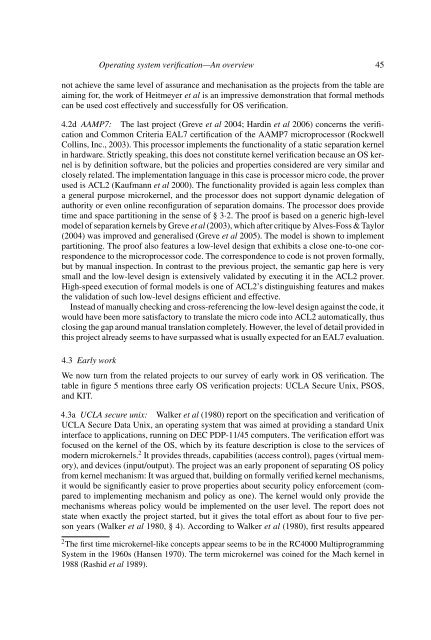Operating system verificationâAn overview
Operating system verificationâAn overview
Operating system verificationâAn overview
You also want an ePaper? Increase the reach of your titles
YUMPU automatically turns print PDFs into web optimized ePapers that Google loves.
<strong>Operating</strong> <strong>system</strong> verification—An <strong>overview</strong> 45<br />
not achieve the same level of assurance and mechanisation as the projects from the table are<br />
aiming for, the work of Heitmeyer et al is an impressive demonstration that formal methods<br />
can be used cost effectively and successfully for OS verification.<br />
4.2d AAMP7: The last project (Greve et al 2004; Hardin et al 2006) concerns the verification<br />
and Common Criteria EAL7 certification of the AAMP7 microprocessor (Rockwell<br />
Collins, Inc., 2003). This processor implements the functionality of a static separation kernel<br />
in hardware. Strictly speaking, this does not constitute kernel verification because an OS kernel<br />
is by definition software, but the policies and properties considered are very similar and<br />
closely related. The implementation language in this case is processor micro code, the prover<br />
used is ACL2 (Kaufmann et al 2000). The functionality provided is again less complex than<br />
a general purpose microkernel, and the processor does not support dynamic delegation of<br />
authority or even online reconfiguration of separation domains. The processor does provide<br />
time and space partitioning in the sense of § 3·2. The proof is based on a generic high-level<br />
model of separation kernels by Greve et al (2003), which after critique by Alves-Foss & Taylor<br />
(2004) was improved and generalised (Greve et al 2005). The model is shown to implement<br />
partitioning. The proof also features a low-level design that exhibits a close one-to-one correspondence<br />
to the microprocessor code. The correspondence to code is not proven formally,<br />
but by manual inspection. In contrast to the previous project, the semantic gap here is very<br />
small and the low-level design is extensively validated by executing it in the ACL2 prover.<br />
High-speed execution of formal models is one of ACL2’s distinguishing features and makes<br />
the validation of such low-level designs efficient and effective.<br />
Instead of manually checking and cross-referencing the low-level design against the code, it<br />
would have been more satisfactory to translate the micro code into ACL2 automatically, thus<br />
closing the gap around manual translation completely. However, the level of detail provided in<br />
this project already seems to have surpassed what is usually expected for an EAL7 evaluation.<br />
4.3 Early work<br />
We now turn from the related projects to our survey of early work in OS verification. The<br />
table in figure 5 mentions three early OS verification projects: UCLA Secure Unix, PSOS,<br />
and KIT.<br />
4.3a UCLA secure unix: Walker et al (1980) report on the specification and verification of<br />
UCLA Secure Data Unix, an operating <strong>system</strong> that was aimed at providing a standard Unix<br />
interface to applications, running on DEC PDP-11/45 computers. The verification effort was<br />
focused on the kernel of the OS, which by its feature description is close to the services of<br />
modern microkernels. 2 It provides threads, capabilities (access control), pages (virtual memory),<br />
and devices (input/output). The project was an early proponent of separating OS policy<br />
from kernel mechanism: It was argued that, building on formally verified kernel mechanisms,<br />
it would be significantly easier to prove properties about security policy enforcement (compared<br />
to implementing mechanism and policy as one). The kernel would only provide the<br />
mechanisms whereas policy would be implemented on the user level. The report does not<br />
state when exactly the project started, but it gives the total effort as about four to five person<br />
years (Walker et al 1980, § 4). According to Walker et al (1980), first results appeared<br />
2 The first time microkernel-like concepts appear seems to be in the RC4000 Multiprogramming<br />
System in the 1960s (Hansen 1970). The term microkernel was coined for the Mach kernel in<br />
1988 (Rashid et al 1989).
















